
Playa Escobillo, Oaxaca.
Turtles of Oaxaca
|
In November 2003, I had a chance to participate in a conservation effort aimed
at increasing the numbers of endangered sea turtles in Oaxaca, the most biologically
diverse state of Mexico.
|

Leatherback turtle (Dermochelys coriacea),
Tortuguero, Costa Rica. |
Of the five sea turtle species occurring in Oaxaca,
two breed in the fall: small olive (also called Pacific) ridley and leatherback
turtle, the World's largest (more than 3 m/10' long, and weighing up to one ton). |

Olive ridley (Lepidochelys olivacea),
Chocutitan, Mexico. |
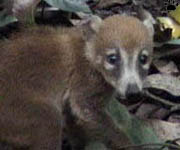 |
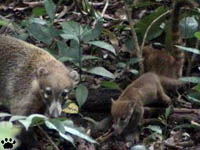 |
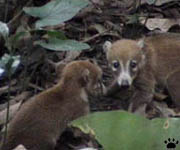 | |
Family of white-nosed coatis (Nasua narica),
La Venta, Mexico. |

Gray fox (Urocyon cinereoargenteus),
Tikal, Guatemala. |
Sea turtle populations worldwide continue to decline
because of poaching, resort development, and ocean pollution. In Mexico, many nests are destroyed by feral dogs, coyotes, foxes, raccoons, and other predators. |
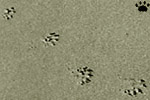
Tracks of raccoon (Procyon lotor)
on a beach, Lost Coast, California. |
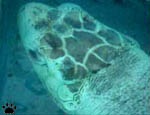
Olive ridley, Monterrico, Guatemala. |
To escape predation, leatherbacks lay eggs very
deep. Ridleys have another strategy, the so-called arribadas: at certain
nights, hundreds lay eggs together on a few beaches, so that all predators can
eat only a small fraction. But now ridleys are too rare for it to work. |

Ridley tracks, Playa Escobilla, Oaxaca. |

Digging up a leatherback turtle's nest,
Playa Escobilla, Oaxaca. |
To increase the turtles' chances of survival,
their nests are dug up It is easy to dig up shallow nests of ridley turtles, but
it takes a lot of work to get to a leatherback's eggs, sometimes laid 1 m/3' deep. |

Leatherback nest (red line marks the size of the
nest and the turtle that made it). Playa Escobilla. |
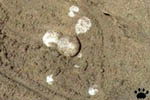
Eggs of olive ridley, Playa Escobilla. |
Each nest contains 30-60 eggs, but the ones on
top usually have no yokes and can't develop. They serve as a distraction, sometimes
letting predators fill up and leave instead of consuming fertile eggs below. |
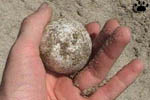
Leatherback eggs, Playa Escobilla. |
 |
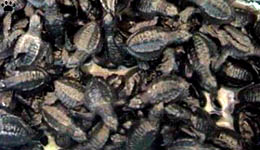 |
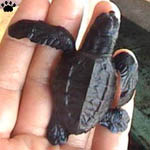 |
| Baby ridleys, Playa Escobilla, Mexico. |

Eggs of olive ridley, Playa Escobilla. |
Eggs are incubated in moist sand for about a month.
Hatchlings are soft to touch, but they are ready to be released almost immediately. |

Leatherback eggs, Playa Escobilla. |

At the height of breeding season, thousands of
hatchlings are sometimes released on a single day.
|
Releasing baby turtles is the best part of the
work. At Playa Escobilla, olive ridley's main breeding site, they are turned into
public holidays, with lots of people attending them each Saturday evening. |
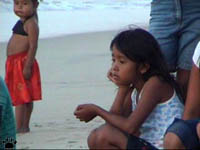
May be these children will take better care of their
land and seas than their parents and grandparents. |
Baby turtle videos: ridleys1.mpg
(1.8 Mb), ridleys2.mpg (6 Mb) |
Baby turtles heading for the ocean.
Part 2. Freshwater turtles.
Home
|